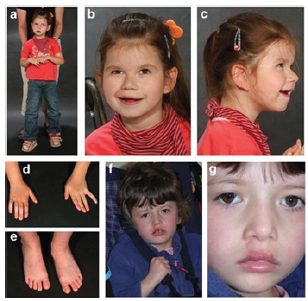Review Article 
 Creative Commons, CC-BY
Creative Commons, CC-BY
A Comprehensive and Clinical Review of Distal Deletion Syndrome of Chromosome 5q14.3
*Corresponding author:Shahin Asadi, Division of Medical Genetics and Molecular Pathology Research, Harvard University, Boston Children’s Hospital, USA.
Received:December 29, 2022; Published:January 10, 2023
DOI: 10.34297/AJBSR.2022.17.002399
Abstract
Cardozo et al. [1] reported 3 unrelated children, 2 boys and 1 girl, with severe mental retardation, epilepsy, and bilateral periventricular heterotopia limited to the subcutaneous region of the temporal bones and occipital lateral ventricles. Using array CGH, Cardoso et al. [1] identified a deletion of chromosome 5q14.3q21 in 3 unrelated patients with periventricular heterotopia.
Keywords: Distal chromosome 5q14.3 deletion syndrome, Chromosomal disorders, Child syndromes
Clinical Signs and Symptoms of Distal Chromosome 5q14.3 Deletion Syndrome
Cardozo et al. [1] reported 3 unrelated children, 2 boys and 1 girl, with severe mental retardation, epilepsy, and bilateral periventricular heterotopia limited to the subcutaneous region of the temporal bones and occipital lateral ventricles. Other features of this syndrome include hypotonia, delayed motor development, lack of speech, and minor facial deformities such as prominent forehead, depressed nasal bridge, and high blood pressure. Also, one of the patients showed polymicrogyria in brain MRI [1] (Figure 1).
Etiology and Discussion of Distal Deletion Syndrome of Chromosome 5q14.3
Using array CGH, Cardoso et al. [1] identified a deletion of chromosome 5q14.3q21 in 3 unrelated patients with periventricular heterotopia. These deletions ranged in size from 6.3 to 17Mb and included a common region of 5.8Mb. Computational critical region analysis identified 14 candidate genes [1,2] (Figure 2).
Sobreira et al. [3] identified a 7.4Mb deletion of chromosome 5 at 5q14.3-q21 in an 11-year-old boy with mental retardation, bilateral iris coloboma, hearing loss, dental malformation, and facial deformity. features, but without periventricular heterotopia, which Sobreira et al. [3] referred to the report by Cardoso et al. who identified a deletion region in the overlapping region of 5q14 in patients with periventricular heterotopia. One of these patients had a unilateral coloboma and shared part of the deletion with the patient reported by Sobreira et al. Comparison of the shared deletion regions between the 2 patients revealed a 2.6Mbp putative region for coloboma and a 1.84Mbp putative region for periventricular heterotopia [1,4] (Figure 3).
Le Meur et al. [5] reported 5 unrelated children with severe mental retardation, absent speech and stereotyped movements, each with deletions between different regions of chromosome 5q14 ranging in size from 216kb to 8.8Mb. The minimal common deletion region contained only the MEF2C gene. Le Meur et al. [5] noted that the 5q14 region partially overlapped with that deleted in patients with periventricular heterotopia reported by Cardoso et al. But only one of those patients has deleted the MEF2C gene. Furthermore, none of the patients reported by Le Meur et al. [5] had periventricular heterotopia [1,5].
Al-Kateb et al. reported an 8-year-old boy with a de novo deletion of 582kb on chromosome 5q15, involving 5genes. They compared their patient’s findings with those of 3patients reported by Cardoso et al. All of them had a minimum overlapping region of about 230kb including 2genes: FLJ42709 and NR2F1. All 5patients had growth delay and facial deformities, 4 had hypotonia and 3 had eye abnormalities. Urinary tract obstruction was observed only in their patient. Periventricular heterotopia was also present only in the patients reported by Cardoso et al. Al-Kateb, et al. stated that NR2F1 is the strongest candidate gene for overlapping phenotypes. Heterozygous mutations in the NR2F1 gene have been identified in patients with Bosch-Boostra-Schaaf optic atrophy syndrome, which is characterized by developmental delay, moderate mental retardation, and visual atrophy [1,3] (Figure 4).
References
- Cardoso C, Boys A, Parrini E, Mignon Ravix C, McMahon JM, et al. (2009) Periventricular heterotopia, mental retardation, and epilepsy associated with 5q14.3-q15 deletion. Neurology 72(9): 784-792.
- Sobreira N, Walsh MF, Batista D, Wang T (2009) Interstitial deletion 5q14.3-q21 associated with iris coloboma, hearing loss, dental anomaly, moderate intellectual disability, and attention deficit and hyperactivity disorder. Am J Med Genet 149A: 2581-2583.
- Asadi S (2022) The Book of Human Abnormality Chromosome. Amidid Publications.
- Brown KK, Alkuraya FS, Matos M, Robertson RL, Kimonis VE, et al. (2009) NR2F1 deletion in a patient with a de novo paracentric inversion, inv (5) (q15q33.2), and syndromic deafness. Am J Med Genet 149A: 931-938.
- Le Meur N, Holder Espinasse M, Jaillard S, Goldenberg A, Joriot S, et al. (2010) MEF2C haploinsufficiency caused by either microdeletion of the 5q14.3 region or mutation is responsible for severe mental retardation with stereotypic movements, epilepsy and/or cerebral malformations. J Med Genet 47(1): 22-29.







 We use cookies to ensure you get the best experience on our website.
We use cookies to ensure you get the best experience on our website.